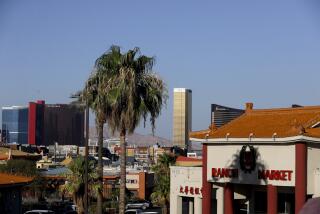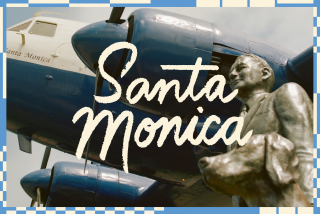CHECKING INTO NEW YORK NEW YORK (THE HOTEL, NOT THE CITY)
- Share via
LAS VEGAS — Central Park teems with bandits, as you may have heard, but they each work with just one arm. New York Harbor is polluted only by pennies. And some sort of high tide has washed those words about “your tired, your poor and huddled masses” right off the base of the Statue of Liberty.
As they say in the song, it’s a wonderful town. The house is up and you’re doubling down.
This is the new Manhattan, a city in caricature and miniature at the corner of Las Vegas Boulevard and Tropicana Avenue, the secrets of its interior closely guarded for months. A joint venture of MGM Grand Inc. and Primadonna Resorts, the New York-New York Hotel & Casino covers 20 acres, offers 2,035 rooms and cost about $460 million to build.
It is a place of familiar and charming architecture, of hotel rooms that are bright and spacious, if not so evocative as the public spaces. It is the unhelpful answer to a classic American tourist’s query: Where can you find a decent New York hotel room for under $100 a night? And right now, it is the most talked about address on the Las Vegas Strip. Everyone, it seems, has either driven past the work in progress (it took two years) or seen a video clip of the fireworks that lighted up its mock skyline when the hotel debuted Jan. 2. But what does this brave new Manhattan look like on the inside?
Of course there is a big apple involved. Perhaps six feet around and coated with mirrors, it twinkles above the Empire Bar while a swing band holds forth below.
Is there graffiti? Yes, inscribed persuasively but incomprehensibly on scattered mailboxes and newspaper racks.
Muggers? No. Although, of course, the gaming tables are designed to accomplish the same result.
Though it’s the fourth major Las Vegas casino opening in the last year--following Stratosphere (at the other end of the strip), Monte Carlo (next door) and Orleans (to the west of the Strip)--New York-New York has been generating extraordinary curiosity ever since construction crews began assembling its tall profile, which includes a 529-foot-high homage to the Empire State Building, a 500-foot Chrysler Building, and a 150-foot Statue of Liberty, who raises her bright torch between them.
As the exterior came to dominate its corner of the Strip, speculation intensified among locals and visitors: Would the interior follow through with the same wealth of witty detail that the exterior offered?
Short answer: The inside is as clever as the outside.
But even now, with all doors unlocked, the crowds can make details inside difficult to distinguish: Gamblers and sightseers wash through the place in large volumes at all hours. In the resort’s first three days of business, the marketing director estimated that 600,000 guests passed through (200,000 per day). In those three days, dodging baby carriages and honeymooners and harried employees throughout the place, I never did find the manhole cover that’s supposed to shoot up steam. (Before the first week of operation was done, industry experts were guessing that New York-New York would bring in $85 million to $100 million yearly.)
This doesn’t mean that every visitor leaves satisfied. On a Friday morning in the snacking-and-strolling area designed after Greenwich Village, Pete Prevas of Baltimore stood at the crowded counter of the Greenwich Village Coffee Co., critically examining a six-ounce cup of brown liquid for which he had waited about 15 minutes. Annoyed by the wait, he threw a couple of bills at the counterman and told him to keep the change. But the counterman needed more. They huddled, and then Prevas raised his voice to make an announcement to the rest of us in line.
“Two dollars and 14 cents. Small coffee. No floor show,” he said, then strode off as a brief rumble of scorn passed through those of us still waiting.
It was a little piece of street theater common enough in that other New York, though perhaps not what the developers had in mind. (Actually, in other corners of the casino, coffee can be found for $1.50, and the rest of the casino, hotel and restaurant prices seemed generally in line with those of competitors. But the man had a point.)
*
The casino areas, much of which sprawl beneath a Central Park canopy of fall leaves, cover about 84,000 square feet with 71 gaming tables and more than 2,400 slot machines (277 of which take nickels). On the second level, a meandering 28,000-square-foot Coney Island arcade area includes bumper cars, laser tag, barkers guessing ages and weights, interactive skiing simulators, and an enticing game of reflexes, violence and unidentified politician caricatures called Wac-a-Mayor. A 1,000-seat theater is to open in May with “Manhattan,” a musical production inspired by the city’s street performers. Also still under construction is an upstairs wedding chapel.
In this Manhattan, is there an old-fashioned Manhattan steakhouse? Yes, Gallagher’s. Are there Nathan’s hot dogs? Yes. Schraft’s Ice Cream? Yes. Is there a Chinatown? No, unless you count the restaurant Chin Chin. A Little Italy? Yes. Apart from Il Fornaio (like Chin Chin, a California-based restaurant chain), there’s a food court area with false brownstones, half-sized fire escapes and faux yet fetching storefronts.
Is there any sign of Donald Trump or George Steinbrenner? No. (Which could help explain the smile worn by former Yankee Dave Winfield when he came in for breakfast on the place’s second day.)
There is no Automat, in fact no buffet at all, a departure from casino customs. But there is a big 24-hour coffee shop called America, with a fanciful 100-foot-long relief map of the U.S. hanging high above the tables. Be wary, though: The waits were long and the service iffy during opening days (circumstances that we can hope will smooth out quickly), and America’s food, like the bland fare I sampled at Chin Chin, was no more than passable.
Upstairs in the hotel, standard double rooms run $89 (for a weekday night) to $129 (weekends). In the corner room I was assigned, I found simple, modern wooden furniture and a purple armchair with a fake leopard-skin cushion in front of a picture window with red casings--details I would have expected in the Hard Rock Hotel. Still, it was pleasant. Staying there did give me the chance to tell people that I was sleeping about halfway up the Empire State tower.
The towers are a clue to the ingenuity of the developers, architects and engineers: Though the New York-New York skyline looks like nine adjacent buildings, all modeled after familiar Manhattan landmarks, it’s basically one building with angled wings of contrasting exterior colors. Thus, a guest can walk from the 25th floor of the Empire State tower to the 25th floor of the Chrysler tower. (When the carpet changes color, a bellman explained to me, you know you’re in a new “building.”)
Is there a bookstore, museum or gallery in this shiny new Manhattan? No, although there are shops inspired by Soho (Chrysler Building letter-openers, $36 each) and Park Avenue (designer fashions). Is there any hint of gay or lesbian life in the Greenwich village set? No. Is there an Apollo Theater? No, but, oddly, there is a Motown Cafe and Nightclub. Also there’s a cigar shop, Hamiltons, where you can get a 6-ounce tube of George Hamilton’s Constant Color Instant Tan Lotion for $22.
Is there a Times Square with lots of neon? But of course. A Brooklyn Bridge? Yes. Is that Frank Sinatra song heard frequently? Yes, about as often as one sees flourishes of Art Deco design: at the check-in desk, in the hotel halls, by the elevators and on the back of the gaming chairs, where faux tuxedos of red, white and black are sewn into the upholstery.
“I think,” said Wayne Newton on opening night, casting an admiring glance on one such chair, “that it did what it needs to do. When you look at the detail . . . it’s just brilliant.”
This begs the question of whether most people are in step, aesthetically, with Wayne Newton. For me and the many visitors I spoke with, the answer is, um, pretty much, yes.
“It’s more like Disneyland than the other hotels,” said an approving Tina Smelser, a teenager who had come with her family from Portland for the first day. “And it has an awesome roller coaster. We went twice.”
Roller coasters are a particular strength of the Primadonna company, which operates one of the world’s tallest and fastest roller coasters, “The Desperado,” alongside its three hotel-casinos in Stateline, Nev. New York-New York’s coaster, known as the Manhattan Express and priced at $5 a ride, rises to a height of 203 feet, weaves among the skyscrapers, plunges 144 feet in a single steep fall, then follows that up with a loop-de-loop and full barrel roll. Speeds are said to reach 67 mph (it seemed faster to me) and a ride lasts about four minutes. Finishing up, the coaster dips down into the casino and rumbles above Little Italy, something like the old elevated trains that once coursed up and down the real Manhattan’s East Side.
“It’s just amazing,” frequent Las Vegas visitor Rick Belt told me as he sat by a Central Park pond one morning. “The authenticity, even down to the graffiti! And the concrete looks like it’s been here for years. I don’t know how they do that. . . . I live close to Orlando, so I’m kind of interested in the rivalry between Orlando and Las Vegas. Orlando is definitely going to lose it.”
I heard one other reaction to the place that took me awhile to categorize. It came from an erstwhile New Yorker, and I finally decided that it amounted to a sort of testimonial, disguised as a complaint.
It came from Dave Mintzer, a 22-year-old student who moved from Coney Island to Las Vegas about three years ago. He wore a Brooklyn Dodgers athletic shirt, and stood in the arcade area that imitates his hometown. Barkers barked, children yelped and toy weapons flashed. It seemed to make him hungry.
“They got no knishes here,” Mintzer lamented, grinning. “Knishes. Big Jewish potato patties. And where are the humongous jumbo pretzels?”
More to Read
Sign up for The Wild
We’ll help you find the best places to hike, bike and run, as well as the perfect silent spots for meditation and yoga.
You may occasionally receive promotional content from the Los Angeles Times.







